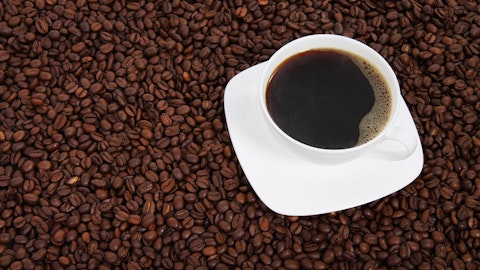As our first retailers have done with us, we also have to be able to deliver an exceptionally high level of service both to our partners, our customers, as well as our end consumers. We pride ourselves on that. Our NPS scores as we’ve talked about are tops and the category. We don’t ever want to lose them. And thirdly, we have to make money. We need to be able to deliver value and so, we’re very proud of what we’ve been able to do to start the process of increasing our expense controls, as well as the movement on our margins themselves. And so, as we put our plan together, we’re very proud of the growth number. We’re significantly above the category in all segments, but it allows us to be able to do all the things I talked about in a really methodical fashion.
So that we know we’re not just building a business, but we’re building a great business.
Sarang Vora : That’s great. Thank you. It’s good to see a balance of growth and profits together. Thank you.
Steve Kadenacy: Thanks, Sarang.
Operator: Thank you. Our next question comes from the line of Joe Altobello with Raymond James. Please proceed with your question.
Joe Altobello: Thanks. Hey guys. Good morning. I had a couple questions on the revenue outlook, as well. I guess, first, what percentage of your ‘24 revenue are you expecting from the wholesale channel in terms of growth?
Steve Kadenacy: We we didn’t guide at the segment level, Joe. But significant growth within the wholesale channel, that’s our primary focus right now.
Joe Altobello: Okay. Any idea what sort of same-store sales might look like in that channel? And how much is coming from new accounts?
Steve Kadenacy: Yeah, we haven’t given that level of detail, Joe.
Joe Altobello: Okay. Understood. Second question on this – the free cash flow guide, the 80% conversion of EBITDA, I guess that would imply about $22 million to $32 million. Could you help us break that down between maybe net income D&A, working capital and CapEx?
Steve Kadenacy: Well, I mean the big tail – I’ll give you the high level, Joe. I mean the big tailwinds are obviously our inventory reduction during the year. The other tailwind that we have is the barter transaction, which gives us, effectively cash free marketing and advertising. Those would be the big tailwinds.
Joe Altobello: Okay. So on inventory, I saw that you said that inventory was sort of at an optimum level at this point. So – but we should expect another reduction inventory in ’24?
Steve Kadenacy: Yeah, I think it comes –expected to come down a bit on the net side, but we do have some reserves in there that we put in the final quarter. So there’s a bit more of a tailwind than would show purely on the net reduction that you’ll see during the year.
Joe Altobello: Okay. And how much cash flow is coming from the barter transaction this year?
Steve Kadenacy: We didn’t – I don’t we didn’t it’s probably about $8 million.
Joe Altobello: Okay. And last one for me. I apologize that the other asset of $23 million, is that related to the barter transaction?
Steve Kadenacy: Yes.
Joe Altobello: Okay. Got it. Thank you guys.
Steve Kadenacy: Thanks, Joe.
Chris Mondzelewski : Thanks Joe.
Operator: Thank you. [Operator Instructions] Our next question comes from the line of George Kelly with Roth MKM. Please proceed with your question.
George Kelly: Hey everybody. Thanks for taking my questions. So the first one for you is on your gross margin guidance. You listed a bunch of – I understand sort of primary reason for the gross margin improvement in fiscal year ‘24, but you mentioned I think four different initiatives that you’re going through that will also help benefit gross margin. And I’m curious if you could just give a little more detail? And I’m especially curious on the RTD side and with respect to RTD, do you anticipate having a significantly higher structural margin in that business now going forward? And I don’t know if there’s any way to kind of quantify what RTD gross margin is, but would love to learn more especially on the RTD side.
Steve Kadenacy: Why don’t I take the core question and Mondz can add color? There’s a few things impacting the gross margin. On unadjusted basis, our gross margin has been hit pretty significantly by the oversupply that we had during the year that goes away. Second is, the natural shift in our total revenue into the FDM side of the business is high margin, 40 plus. Third, and this is just part of being a good CPG business is you’re always refining the supply chain. And our team is working very hard on market – on the logistics side and the manufacturing side to squeeze margin out. Those things all combined are going to give us that significant improvement. And I’ll maybe hand it over to Mondz to talk about the RTD side.



